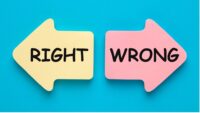Moral disagreement can be painful and involve deeply held beliefs. This combination may lead to conflict and even more disagreement—as a pebble dropped into a pool of water with ever-expanding effects.
Because moral disagreement is so prevalent in a pluralistic society it deserves serious thought. Consider the following questions: What is moral disagreement? What causes it? What occurs during disagreement? What are the consequences of moral disagreement?
What is moral disagreement?
Moral disagreement is a difference of belief about strongly held convictions. Convictions occur on a continuum—mild, moderate, strong conviction, and moral certainty. Some persons are morally uncertain and others morally certain. This uncertainty and certainty many times (but not always) evolves into moderate conviction. Morally certain persons are more likely to remain absolutely convinced. Person’s beliefs about one issue does not always apply to other issues. One can be morally certain about one issue but uncertain about others. And yet, some persons are morally certain or uncertain about a variety of issues.
What leads to moral disagreement?
In many cases the difference in belief is based on having different information, a difference of opinion about how to interpret information, or strongly held beliefs about others’ thoughts, attitudes, beliefs, and behavior. The latter is difficult to surmount because many times it’s based on absolute conviction. What may be changed and what may resolve the disagreement are comparing and contrasting, analyzing and examining the information that is the basis for the core belief. If one or both parties can come to an agreement about the essential data supporting the two views of each other’s beliefs, attitudes, and behavior, sometimes disagreement may be seen as a misunderstanding.
What occurs in moral disagreement?
What happens if the disagreement is not mere misunderstanding, or the misunderstanding can’t be easily resolved with new data or interpretation? Then conflict arises. Part of the conflict is frequently the complexity and plethora of data to be interpreted. Human beings can only process a circumscribed amount of information and detail at one time. Anyone who tries to influence the outcome negatively or with spurious data can confuse the issue.
What happens during a disagreement that leads to conflict? First and foremost, is the inability of one or both members of the disagreement to see the other’s perspective or the inability to have imaginative empathy for the other’s arguments. Another potential issue is the inability to accept another’s different beliefs, attitudes, or behavior. In some cases, that may not be an inability, but rather an unwillingness or lack of care or interest in understanding the other person as a result of time constraints, fatigue (what is sometimes called compassion fatigue), or a lack of interest in resolving the disagreement.
Why is this issue so important in healthcare? Because as in life, the consequences of moral disagreement may lead to irresolvable impasses and conflict if left unresolved, unless both parties can agree to disagree.
In healthcare there are many issues about which patients and providers disagree, ranging from birth to death. These disagreements often appear when least expected. One bioethicist suggests that prominent issues and dilemmas be resolved by society for whole classes of people, not on an individual basis. Others believe in casuistry, which is the determination of one’s beliefs based on a case-by-case analysis of the given data for a particular issue.
The problems with global solutions to disagreement are that they tend to promote the common good at the expense of individual rights. The conflict between the benefits of a decision for society may deeply disadvantage the individual patient. There is always a tension between protecting human rights on a mass scale and the rights of an individual and between protecting or believing one is protecting society and protecting individual rights. John Stuart Mill wrote in On Libertythat in a general sense one as an individual ought to be able to do whatever one chooses to the extent that one’s actions do not infringe on another’s rights.
What are the consequences of moral disagreement?
The most important consequence is the impact on trust. How disagreements are resolved— equitably, judiciously, impartially—determine how our patients see us and our system of healthcare. In some cases simply following the law is sufficient. This protects our patients’ legal rights and their right to disagree with us and our manner of providing healthcare.
In some cases the argument is more nebulous and ethical rather than already codified in the law. Whether an ethical or legal issue, listening to and accurately interpreting our patient’s concerns, and trying to understand a different perspective, always allowing for the possibility that we may be mistaken about our grounds for belief, is essential. In addition, certain aspects of a situation may be unknown. Again, making assumptions or allowing prejudice or stereotypes to intervene complicates the disagreement.
In such a pluralistic society disagreements occur and healthcare is no exception. Moral imagination may be the solution—an ability to imagine the moral attitudes beliefs and emotional status of the other. That includes trying to become the other in moral sentiment for a time to develop an understanding of our differences; trying to imagine another’s pain or perplexity; or trying to imagine another’s goals, aspirations, or internal moral conflicts and self-disagreements.
Seeking true understanding
Disagreements are ubiquitous and moral disagreements in healthcare frequent. Developing a moral imagination and the willingness to withhold judgment and imagine another’s predicament may be one solution to moral disagreement. Moral disagreement, as with other decisions, requires appropriate judgment. Appropriate judgment requires as much information as possible, accurately interpreted. Listening and trying to collect data from the primary source as historians do is essential. The primary source or the patient who is a “good historian” is our most basic asset. Many disagreements can be solved with adequate and accurate data.
Once data has been collected and analyzed, interpreted and a conclusion drawn, moral imagination may bridge the gap between one person and another— our patients and ourselves—if disagreement still exists. If I as a practitioner can imagine another’s most deeply held moral beliefs, accept and understand them, healthcare may seem more welcoming and hospitable to the many patients we serve. Moral disagreements will always exist but may not seem insurmountable or alienating if moral imagination leads to true understanding.
Mary Ellen Wurzbach is John McNaughton Rosebush Professor Emerita, University of Wisconsin – Oshkosh in Oshkosh Wisconsin.



















8 Comments.
In the healthcare field there are a lot of moral disagreement, but if healthcare professional abide by the code of ethics and come to an agrrement in a professional manner, it can be surmountable. Thanks for the literature!
Everyone’s belief system is different, and it will always be a topic for moral disagreement. For example, nurses are professional healthcare workers, and professionalism requires the analysis of the evidence-based practice and open conversations. Open conversations give opportunities for discussions and understanding each other’s ideology and philosophy. It is very important not to be prejudice, judgmental, or have stereotype thinking during open conversations with patients or clients, so everyone can feel safe and understood. As a result, nurses could have a chance to educate clients, if needed.
I love this “healthcare may seem more welcoming and hospitable to the many patients we serve. Moral disagreements will always exist but may not seem insurmountable or alienating if moral imagination leads to true understanding.”
A new concept for me is “Moral Imagination.” I have utilized this concept since I was young, but I never knew what it was termed. Thank you!
Why does nursing have to develop different language than everyone else uses to discuss the same thing? Calling bullying something that makes it sound “nicer,” moral disagreement, when the rest of the research world is calling it either moral injury or moral distress. By doing this we make it almost impossible for those doing research to carry out the job in a meaningful way. It is destructive in that it perpetuates a lack of solutions.
I agree Ann, when I have to look up more than three words to figure out where a sentence is going I lose meaning. If you are really wanting to reach out with a message then make it understandable.
agreed
The term bullying carries stigma and has become loaded language. It’s easier to come to resolution when it’s approaced as a moral disagreement. If I’m accused of being a bully, I’m less likely to respond in a manner that will attain a solution. Moral disagreement implies that there is more than one entity involved and is empowering. I have the power to work towards resolution. The unfortunate complexity of research and language development means that there are multiple labels for a single concept. Being able to encompass all of the labels for the concept into a linguistic “cloud” allows for academic fluidity. However, I agree that I found the article a bit difficult to read. (I had to look up pluralistic). I think the language should have been tailored to be more inclusive of different knowledge levels. A concept this vital needs to be more linguistically accessible.